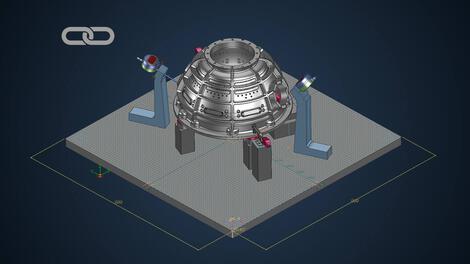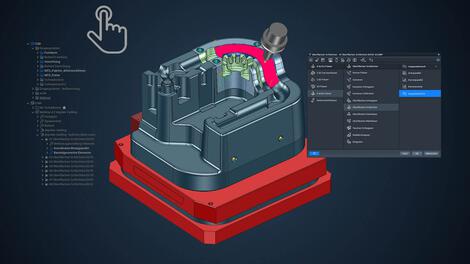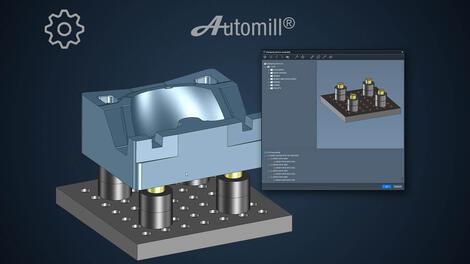The new Tebis: Optimized for manufacturing
Interview with Peter Obermaier, overall coordinator
Completely taken apart, outdated parts discarded, proven features retained, many improvements, new features added: Peter Obermaier is primarily responsible for the overall coordination of 4.1. He summarizes the background and objectives in the first interview in our series on 4.1. What you’ll learn:
- How the parametric/associative Tebis system base differs from other parametric systems and paves the way for a complete end-to-end system
- Why the new user guidance is especially user-friendly
- How customer processes can be better automated and digitalized with 4.1
- How you can use the modular technology kit to flexibly close efficiency gaps in your company



Mr. Obermaier, you’ve been coordinating everything at Tebis that pertains to 4.1. Now the new version is ready. What do you have to tell us about it?
First of all: We’re generally organized in independent teams at Tebis. My task is to bring everyone together who’s working on and with the new version across the different departments – from software development, product management and technology teams to marketing and support. So back to your question: Project partners from our customer base have thoroughly tested the first release of the new version. The response was very positive. To tell you the truth, it's a tremendous relief. And I'm looking forward to our customers now being able to work with the new version.
Very specifically, what are your customers expecting?
With the new version, we’ve pursued three major goals. The first goal is to establish an end-to-end platform with the new CAD system base. This lays the groundwork for ongoing developments: Over the medium term, we want to offer our customers in all sectors and industries a complete system they can use to create models, molds and dies – no matter what manufacturing tasks are involved. The second goal is to logically and intelligently structure the software with clear and simple user guidance. Third, we’re taking the next step toward automation and digitalization with the CAD system base, and also with the integrated virtual clamping device library and the improved connection to ProLeiS MES.
Parametric/associative system basis and solid kernel
The foundation for a complete end-to-end and manufacturing-oriented system
By the new CAD system base, do you mean the parametric/associative system base?
Yes. This is joined by our solid kernel.
Now honestly, Mr. Obermaier: Parametric/associative design, a solid kernel … this isn't exactly new. So why have you put so much work into a new system base?
Over 35 years ago, Tebis was the first company to launch software that could be used to create NC programs for 3D models right on the PC. And it wasn’t just large companies like BMW that benefited from this innovation. For small and medium-sized suppliers in particular, it was their first chance to set foot in the world of computer-supported NC programming.
So would you say there's a special place in your heart for medium-sized manufacturing-oriented companies?
And it has remained that way to this day. We wanted to establish a system base that was absolutely manufacturing-oriented – with no compromises. But we quickly learned that the devil is in the details. Our software has to be robust.
And that means?
If I load you down with tight deadlines, you need a consistently stable manufacturing operation. It’s absolutely essential to efficient data preparation to be able to intersect surfaces like draft angles with volumes or open and closed solids without triggering error messages. That’s why Tebis always calculates a result, even if gaps are present. And it’s also why we don’t make a distinction between open and closed solids. This is what we mean by a robust and manufacturing-oriented solution.
And your kernel is optimized for this.
Yes. Our customers will fall in love with parametric design: It offers numerous useful options for data preparation that many of our customers probably don’t even know about. And parametric design has many advantages, even for NC programming.
Clear and user-friendly guidance
The software thinks along with us
Let's go on to the next goal. What do you have to say about clear and simple operation?
By nature, software evolves functionally with each new version and release. As a service-oriented company, it’s extremely important for us not only to provide all the necessary functions, but also to design the software so that the user can interact smoothly with it. Before we even started modifying the software, we therefore asked key users among our customers what we could do better.
And what was the result?
I'll be honest with you, all the feedback from our customers boiled down to one main response: There’s not much to complain about from a functional standpoint. But searching for some settings takes too long, and it takes too many clicks to complete a task.
So you analyzed this more closely.
Of course. We took the software apart and worked with our project partners to scrutinize it for usability and user-friendliness. With Version 4.1, we’re pursuing the goal of making its operation more straightforward and understandable.
So to put it plainly?
Let us surprise you. My colleague Dr. Wolfgang Schinke will tell you more about this. I’ll tell you this in advance: Our users told us how they usually work in NC programming. The user guidance reflects the logical sequence of the individual work steps.
More automation and digitalization
Focus on customer processes
You mentioned automation and digitalization as another goal. These issues have already been in the works for you for a long time. What do you want to emphasize about version 4.1?
First of all, it's about simplifying the daily work of CAD designers and CAM programmers with automation options. But secondly, it's also about better automating the actual manufacturing. The focus is on the customer's actual manufacturing processes. The key words are the simulation technologies where the clamping devices are now integrated and a better connection to ProLeiS MES.
Can you please explain that in more detail?
You were already able to generate CAM programs using templates in Tebis, where all the company’s manufacturing knowledge is digitally stored. We’re continuously improving and refining CAM template technology. With parametric design, repetitive work steps can now also be executed using templates in CAD design. This realized the goal of accounting for our customers' manufacturing processes in design and data preparation, which offers an enormous time advantage. We also have what we call "programming with the virtual machine." In Tebis, you plan and program right from the start using digital twins of the real manufacturing environment. Here’s where version 4.1 closes an important gap: Now clamping devices can also be completely mapped and configured in the virtual world with no manual effort.
Would you say that virtual machine technology bridges the gap between standardized and manufacturing-oriented CAD design and NC programming on one hand and automated manufacturing on the other?
That pretty much hits the nail on the head. Because the user can plan and program in Tebis using digital twins right from the start, all they need to do is send collision-checked NC programs to the machine and don't have to give any thought to what happens after NC output.
And the improved connection to ProLeiS MES?
That's the next step on the path to digitalization. Our ProLeiS MES software also digitally maps manufacturing processes. This process is now much smoother in version 4.1.
A modular technology toolkit
Closing gaps in efficiency
There are a lot more new features in 4.1, like the new product structure. Can you please give us a few words about that?
The new product structure is designed as a modular technology toolkit. These modules are designed for special technical requirements. This allows companies to close specific gaps in efficiency – whether they already use Tebis or not. For example, if you only want to use a workstation for roughing, go ahead. Theoretically, a company that only wants to do deep drilling with Tebis but is otherwise using a different CAD/CAM software can now use our automated solution for deep drilling. Our users will also find the restructuring of our products in technologies reflected in the user interface.
Mr. Obermaier, you’ve actually turned some things upside down. Isn't that a big change for your users?
Absolutely. We made many changes, from the new object tree to the Job Manager, and a number of parameters and functions have been "moved." But Tebis is still Tebis. Users will quickly get their bearings. Overall, operation is much simpler and more logical. And we won't leave anyone standing out in the cold. Of course, we offer comprehensive update training courses. I especially want to highlight our customer support. Because that’s also an important strategic goal for Tebis! Partnership: We place great value on personal contact and on quickly and directly supporting our users. Of course, we’re also actively supporting our customers in the transition to version 4.1.
And then there’s also the new Tebis Community….
Exactly. All of our customers with a maintenance contract can access our new Tebis Community. That’s where they can find lots of useful tips and tricks for using the software. Our customers can also exchange information there. The site currently provides more background information on version 4.1 as well as many videos explaining the differences between version 4.0 and version 4.1 in detail.


